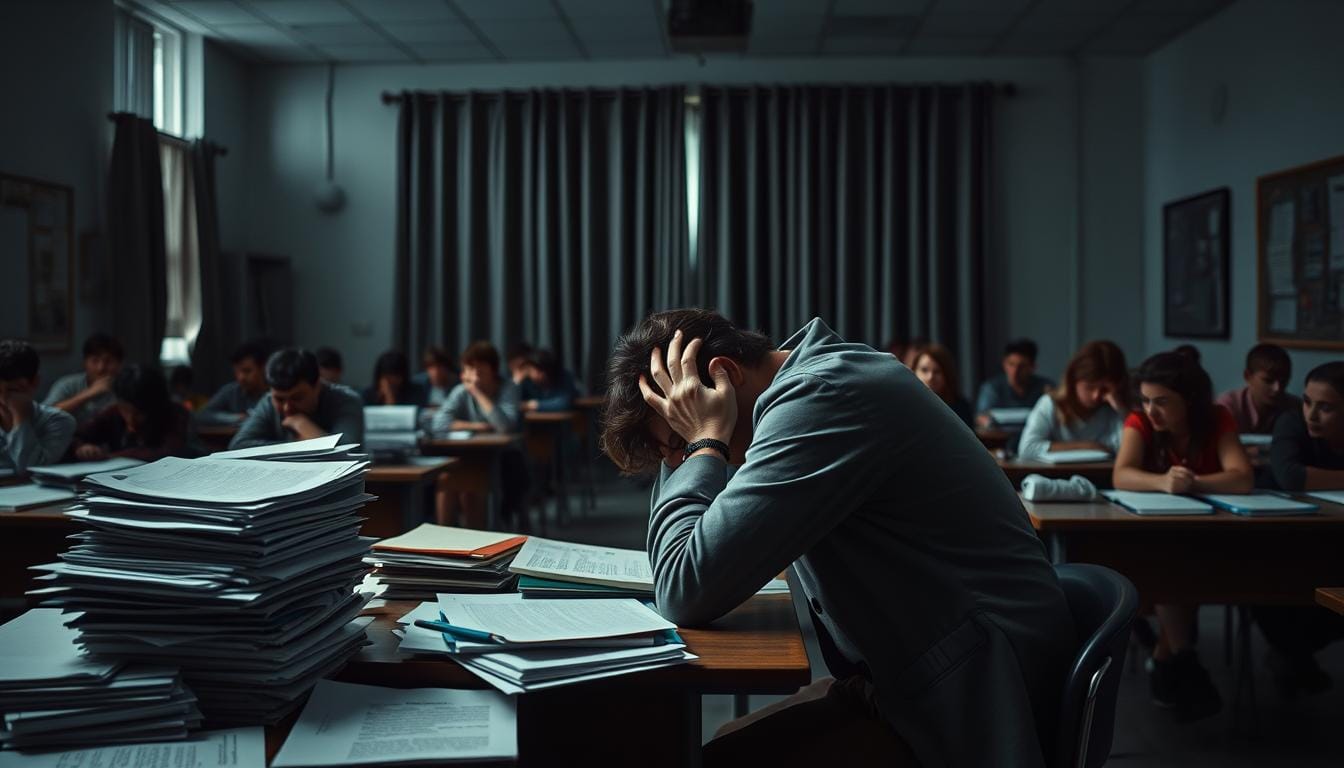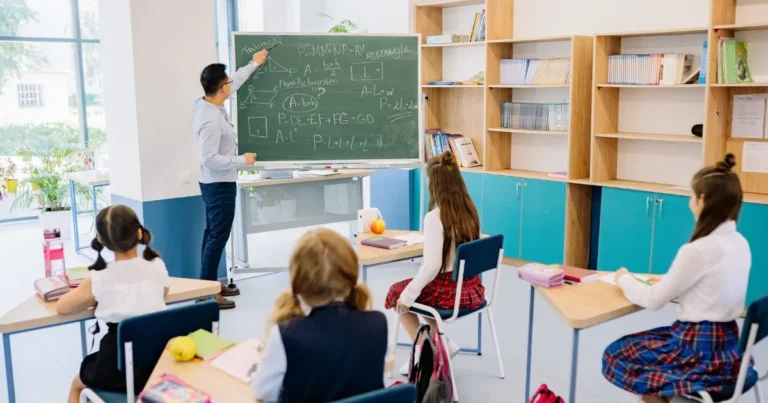Teacher Burnout: Signs, Causes, and How to Prevent It
Every classroom has a silent struggle brewing beneath the surface. As an educator, you know the passion that drives teaching. But you also understand the mounting pressure that threatens to extinguish that spark. Teacher burnout has become more than a buzzword – a critical crisis affecting educators across the United States.
The statistics are stark and sobering. 90% of teachers recognize burnout as a serious problem. 44% reported that they frequently feel overwhelmed. The educator stress is real, transforming what was once a noble profession into an increasingly challenging career path.
This article will dive deep into the world of teacher burnout. We’ll explore its roots, impacts, and most importantly, strategies to combat this pervasive issue. You’ll discover why so many dedicated educators are feeling pushed to their limits. And learn practical approaches to restore balance, passion, and purpose to your teaching journey.
From understanding the warning signs to implementing supportive strategies, we’ll provide a comprehensive roadmap. Your well-being matters and this guide is designed to support you every step of the way.
Table of Contents
Understanding Teacher Burnout in Modern Education
The education world is facing a big problem: teacher burnout. A huge 90% of teachers say burnout is a big deal. This issue is now a major problem in schools today.
Teachers are feeling more exhausted than ever. Their job is getting too hard. They have too many tasks at once, making their job very stressful.
Defining Professional Exhaustion
Professional exhaustion in teaching means:
- Too much work all at once
- Feeling emotionally and physically drained
- Staying stressed and tired all the time
Impact on the Education System
Teacher burnout has big effects. Almost 50% of teachers quit in their first five years. This disrupts learning for students and causes problems in schools.
“Teacher burnout is not just an individual problem, but a systemic challenge that impacts entire educational ecosystems.”
| Burnout Indicator | Percentage |
|---|---|
| Teachers feeling “very stressed” | 44% |
| Teachers leaving within 5 years | 50% |
| Turnover attributed to burnout | 30% |
Current Statistics and Trends
Numbers show how tough things are for teachers. They work 50 hours a week, way more than expected. But, schools with good leaders have 20% less burnout. This shows how important support is.
Fixing teacher burnout is key to keeping education good and stable. It’s not just about helping teachers; it’s about keeping schools strong.
Common Signs of Teacher Burnout
It’s important to spot teacher mental health issues early to stop burnout. The signs can be small but very important. They affect how well a teacher does their job and their overall happiness.
Teachers who are burning out show certain signs:
- Chronic emotional exhaustion that lasts longer than usual stress
- Feeling cynical about teaching
- Seeing a drop in their work quality
- Physical signs like headaches or trouble sleeping
“Burnout is not a badge of honor, but a critical signal your mental health needs attention.” – Educational Wellness Institute
Numbers show how big this problem is. About 44% of K-12 teachers often feel burnt out. More than 50% are thinking about retiring early. This emotional strain can make them lose motivation and even quit their job.
Some behaviors to watch for include:
- Stepping back from talking to students
- Less excitement about planning lessons
- Feeling short-tempered in class
- Struggling to keep work and personal life separate
Knowing these signs helps teachers get help and take care of themselves before burnout gets worse.
Key Causes Behind Educator Stress
Teaching has become a tough job, with many stressors affecting teachers’ work-life balance. The modern classroom is full of challenges that test teachers’ limits.
Recent studies show the high pressures teachers face. Almost 44% of K-12 teachers often feel burned out. Classroom management is a big problem for them.
Workload and Time Management Challenges
Teachers often deal with too much work. Key issues include:
- Too much administrative paperwork
- Working long hours outside of class
- Preparing lessons and grading
- Handling extra activities
“The amount of work outside classroom hours is crushing educators’ spirit and passion for teaching.” – Education Researcher
Administrative Pressures
Schools add stress with:
- Tight performance evaluations
- Changing curriculum rules
- Little professional growth chances
- Lack of support from leaders
Student Behavioral Challenges
Managing classroom behavior is a big stress for teachers. About 29% say student behavior is a major stress. It makes it hard for them to keep a good learning space.
It’s important to understand these causes. We need to find ways to help teachers and make their job better.
Physical and Emotional Manifestations

When educator stress builds up, teachers go through big changes. These changes affect their work and personal lives a lot. Teacher mental health is very important as burnout shows up in different ways.
The physical signs of educator stress often include:
- Chronic fatigue affects 43% of teachers
- Persistent headaches and muscle tension
- Weakened immune system leading to frequent illnesses
- Sleep disturbances occurring in approximately 40% of burned-out educators
Teachers feeling burned out also face tough emotional challenges. About 40% of them have more anxiety than others. They feel:
- Increased irritability (up to 60% of cases)
- Emotional detachment from students and colleagues
- Loss of enthusiasm for teaching
- Feelings of inadequacy and self-doubt
“Burnout is not a badge of honor, but a serious signal that something needs to change in your professional life.” – Anonymous Educator
Recognizing these signs is the first step to getting better and keeping teachers mental health healthy. Knowing how deep educator stress is helps teachers find the right support. It also helps them take care of themselves.
The Rising Crisis of Teacher Burnout
The education world is facing a big problem with teacher burnout at an all-time high. Recent data shows a worrying trend that could harm our schools.
After the pandemic, teachers are under more stress than ever. They’re dealing with challenges that go way beyond just teaching.
Alarming Statistical Evidence
The numbers show how serious teacher burnout and exhaustion are:
- 44% of K-12 teachers say they’re burned out “often” or “always.”
- 55% are thinking of leaving sooner than they planned.
- 8% of teachers quit every year, with the youngest ones most at risk.
| Burnout Indicator | Percentage |
|---|---|
| Teachers experiencing high stress | 44% |
| Teachers considering early retirement | 55% |
| Annual teacher turnover rate | 8% |
Long-Term Systemic Consequences
Teacher burnout has big effects on schools. High turnover rates mess up student learning, cause knowledge gaps, and lower school quality.
“The health of our education system depends on supporting our teachers through unprecedented challenges.” – Education Policy Expert
It’s key to understand these issues to keep great teachers and keep schools top-notch.
Creating Supportive School Environments

Building strong teacher support systems is key to stopping educator burnout in today’s schools. Schools now see the importance of protecting their most precious asset: their teachers.
“A supportive school environment is not a luxury, but a necessity for sustainable education,” says Dr. Emily Richardson, education policy expert.
Here are some ways to build a supportive school environment:
- Implementing regular wellness check-ins
- Providing mental health resources
- Creating collaborative professional development opportunities
- Establishing clear communication channels
Studies show that supportive school cultures have big benefits. They find that classrooms with a supportive vibe see:
| Support Metric | Improvement Percentage |
|---|---|
| Student Engagement | 20% |
| Student Attendance | 15% |
| Reduction in Behavioral Issues | 25% |
School leaders can boost teacher support by:
- Recognizing teacher achievements
- Offering flexible professional growth paths
- Reducing administrative bureaucracy
- Providing mental health benefits
By focusing on teacher well-being, schools can build strong educational communities. These communities support both teachers and students in important ways.
Professional Development and Resources
Educators today face big challenges in keeping their mental health and doing well at work. Teacher support systems are key to tackling stress and burnout in schools.
Modern schools know how important it is to support teachers well. Studies show that 44% of K-12 teachers often feel burned out. This shows we need strong support for teachers.
Mental Health Support Systems
Good mental health support for teachers needs many parts. Schools can start programs to help teachers feel better:
- Confidential counseling services
- Stress management workshops
- Peer support networks
- Regular mental health check-ins
Skill Enhancement Programs
Growth opportunities can help teachers avoid burnout. Programs that help teachers learn new skills can make them stronger and better at teaching.
| Program Type | Focus Area | Potential Impact |
|---|---|---|
| Communication Training | Conflict Resolution | Improved Interpersonal Skills |
| Technology Integration | Digital Classroom Skills | Enhanced Teaching Effectiveness |
| Emotional Intelligence | Student Interaction | Better Classroom Management |
Collaborative Learning Opportunities
Working together is a strong way to support teachers. Studies show that 67% of teachers value their relationships with colleagues for their well-being.
“Collaborative learning transforms individual challenges into collective strengths.” – Educational Leadership Insight
By investing in strong support systems, schools can help teachers grow. This leads to better teaching and happier teachers.
Work-Life Balance Strategies for Educators
Keeping a healthy balance between work and life is key for teachers today. Almost 60% of educators feel burned out. So, finding good work-life balance strategies is vital for their well-being.
How you manage your work-life balance can change your teaching life. By using self-care, you can lower stress and feel more fulfilled at work.
“Teaching is a marathon, not a sprint. Protect your energy and passion.”
Key Strategies for Teacher Self-Care
- Establish clear professional boundaries
- Prioritize personal time and hobbies
- Practice mindful time management
- Utilize digital scheduling tools
- Engage in regular physical activity
Managing your time well is crucial for work-life balance. Studies show that teachers who manage their time better can cut stress by up to 30%.
| Strategy | Potential Benefit |
|---|---|
| Digital Scheduling | Save 5 hours per week |
| Task Delegation | Reduce workload by 20-30% |
| Professional Development | 15% improvement in stress management |
Remember, self-care is not selfish. Taking care of your mind and emotions makes you a better teacher. Using these strategies can help you stay passionate about teaching while keeping your health in check.
Building Teacher Resilience
Teaching is a tough job that needs a lot of emotional and mental strength. It’s key to helping teachers deal with the stress they face every day. With 90% of teachers feeling burned out, it’s more crucial than ever to focus on self-care.
Stress Management Techniques
Learning to manage stress can change how you teach. Resilient teachers build better relationships with students and parents. Here are some strategies:
- Practice mindfulness meditation
- Establish daily reflection routines
- Utilize deep breathing exercises
- Create structured time for personal interests
Professional Boundaries
It’s vital to set clear boundaries in your teaching career. This helps prevent burnout and keeps you effective. Here are some ways to set boundaries:
- Define clear work hours
- Learn to say no to extra work
- Keep work and personal life separate
- Communicate your expectations clearly
Self-Care Practices
Regular self-care can greatly reduce burnout. Teachers who join wellness programs see a 35% boost in mental health. Focus on activities that keep you physically and emotionally strong:
- Regular exercise
- Adequate sleep
- Healthy nutrition
- Regular mental health check-ins
“Resilience is not about being perfect, but about bouncing back from challenges with grace and determination.” – Education Wellness Expert
Building resilience is an ongoing journey. By taking care of yourself, you protect your well-being and become a better teacher.
Conclusion
Preventing educator burnout needs a big plan that tackles the tough issues teachers face. With 44% of teachers often feeling burned out and about 8% leaving each year, it’s time for big changes. Your help in building teacher strength can change education.
Teaching is tough, with over a third of new teachers leaving in five years. We need better support systems fast. Focusing on mental health, managing workloads, and training can help teachers stay strong and improve schools.
Seeing how teacher well-being and student success are linked is key. Schools can support both teachers and students better. It’s not just about helping teachers; it’s about changing how we support education. Your efforts can turn tough times into chances for growth.
We all need to work together to make things better. School leaders, lawmakers, and teachers must join forces. By making small steps and building strong support, we can change education for the better. This will make schools better places for everyone.








